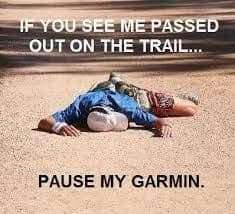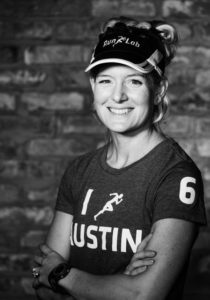THE MYTH: There is a “right” way to run and wearable tech can coach you to “better” form.
THE REALITY: Wearable tech is great, but only if you know what to do with that mountain of data. Any type of data that claims to “coach” you into having better form is flawed in its approach. Why? Because it can’t possibly know what “perfect” is when it comes to the combination of unique structural characteristics, range of motion strengths, limiters, and even goals that make up, well, you.
A while ago, my husband, Jonathan, and I stumbled wearily through the door after a long drive home. We had just come from another full-day adventure race in which we had biked, paddles and run hard through the woods for nearly 18 hours. It took us 20 minutes just to get down the hallway to our condo because our legs were so fried. I hopped immediately in the shower to rid my hair of all the sticks and pokey things that come with bushwhacking through Texas underbrush all day, only to emerge from the bathroom to find Jonathan stumbling around and around the kitchen island like a crazy person.
He was dropping leaves all over the kitchen and had to hold himself up with the countertop just to keep from falling over.
“What on earth are you doing?”
He said the one thing I hoped he wouldn’t. The thing I will incessantly tease him about forever more, and the thing that has altered the course of human fitness in one fell swoop.
“I’m just trying to get a few more steps in. I’ve almost hit my step-count record!”

I primarily work with athletes; however, the term “athlete” runs the gamut from Olympic medalists to overweight tech workers training to run their first straight mile. Every patient provides a unique challenge and I love each and every one of them, even when they drive me crazy. Part of getting to know my patients involves delving into training details, and every day I hear constant, incessant talk about data — from step count to heart rate, cadence, mileage, vertical oscillation, speed, whatever. You name it, my patients want to measure it.
But is this data even useful? My own personal MapMyRun app alerts me to the fact that I’m “in the top 10%!” Pretty much every time I run, complete with a tiny trophy symbol. Really? Because if I run even just with my staff, I can tell you I will be solidly mid-pack every single time, no matter how hard I try to clamber up the ranks.
For anyone who’s ever run a race of any kind, even a race with the random guy next to you on the trail who doesn’t know you’re racing him, you know the golden rule of racing is that your placing is entirely dependent on who shows up. The same thing can be applied to apps and wearable tech. The trend is skyrocketing in the direction of “more is better” when it comes to data. There are many apps and gadgets that create friendly competition between you and your geographic peers. There are also apps that claim to help you “learn to run properly” and can load you up with as much data as you consume.
But is it useful? Does all this data really help the average recreational runner, or does it cause more harm than good?
As someone who treats athletes day in and day out for years, I can tell you that it is — if it’s in the right hands. My biggest concern with wearables is this: pigeonholing. No two people are alike in the way they run and move. Are there commonalties? Of course. But to say, for example, that the “ideal” running cadence is 180 and everyone should work to achieve this gold standard is a VAST oversimplification.
Even something as simple as cadence is relative to the runner. At RunLab, we work with patients every day who do much better with a lower cadence and many who do well with a higher one. There are so many factors that go into just this one aspect of running, including available range of motion in the hips, ankles, feet, knees, and even upper body, both statically and functionally. Lower body strength, history of injury and arthrosis, compensation patterns, leg length, and more. These things all matter in determining an ideal number for even just this single variable.
To have a watch or an insole or some other gadget tell you that you are doing something right or wrong based on a cross section of the population’s characteristics or based on the mechanics of a population of elite runners may end up leading you down a road of inefficiency or, worse yet, injury.
Don’t get me wrong. I’m a huge fan of data in my practice. As a recreational runner, my own running life is very low tech, as I believe if you listen closely to your body, it will tell you what you need to know. I have run 40 to 70 miles per week and raced injury free for years while constantly improving my times, which isn’t bad for a 40-year-old adult-onset runner. I’m not Kenyan, but most of us aren’t. Most of us just want to be able to run and race into old age and we do it for the sheer joy it provides.
The challenge is that most people don’t know what they are listening for when it comes to training. They don’t recognize the signs of overtraining, don’t know the difference between threshold and tempo runs, can’t feel the proprioceptive difference between two different types of shoes or two different cadence rates, and don’t know how to engage certain muscles more than others when they walk or run.
The advancement of wearable data to track these things seems, at least on paper, like the perfect solution. It can be, if the data is used properly. If used to track personal progress, to communicate between health practitioners, coaches and athletes, this data can be invaluable. If used by Mary-Jo Brand New Runner to coach herself to run like Men, this is only setting up people for disaster.
IN SUMMARY:
- DON’T use tech as a means to try and achieve “perfect running form.” There’s no such thing across a population, and wearables can’t take your structure into account.
- DO use wearables to gain knowledge about yourself and your tendencies.
- DO use it as a means to communicate with a coach or doctor (but only if the doctor specializes in runners and understands how to properly utilize the data).
- DON’T overthink your running. Your body will always run in its most efficient current state unless you are struggling with an injury, and if you are trying to change a variable, don’t change more than one at a time.
- DO remember that changing a variable takes commitment and often takes guidance from a knowledgable source. Remember you built these movement patterns over months or years; change takes time.
- DO have a reason you are trying to make a change. Don’t just change something in your run because you think you are supposed to run a certain way or because many elite runners share that characteristic.
- DO work with someone who understands biomechanics and can help you determine what changes make sense based on your personal structure, goals and limiters.
Thank you for taking the time to read our RunLab™ Blog! We hope that you use this information to run more injury free and to optimize your running performance.
For more information about the RunLab™ team and to get your running stride analyzed by one of the preeminent gait specialist teams in the country, please visit WWW.RUNLABAUSTIN.COM
Outside of the Austin area? You can still have your running stride analyzed by one of the best teams in the country. Just visit WWW.RUNLAB.US to see where our partner filming locations are based or choose the self-film option.
RunLab™. Helping runners help themselves.
ABOUT DR. DAVIS

Dr. Kimberly Davis is the Founder & CEO of RunLab™, a motion analysis and gait diagnostic company headquartered in Austin, Texas that provides runners anywhere in the country access to comprehensive gait evaluation services through www.RunLab.us. An Ironman triathlete and ultra-distance adventure racer herself for over 20 years, Dr. Davis has dedicated her career to the study of clinical biomechanics and helping runners get back on the trails, improve their performance and enjoy running again. Working as part of sports medicine teams for over a decade, she grew tired of hearing her patients say they had been told not to run or that “running is bad for your knees” by their doctors without any discussion about biomechanics. She launched RunLab™ Austin in 2014 as a running-centric healthcare facility built entirely by, and for, runners. It has since grown to become one of the nation’s preeminent gait evaluation and training facilities in the U.S. Working with every age and experience level runner, from Olympic gold medalists and world champions to brand new runners, kids, and runners with special needs such as down syndrome, cerebral palsy, and a wide variety of movement disorders. Recognizing a lack of consistency and quality in gait analysis across the country, Dr. Davis launched RunLab.us in 2018 as a means for runners to access her industry-leading gait team from anywhere in the United States.

LEARN MORE:
RunLab™ Podcast RUN.
RunLab™ YouTube channel
